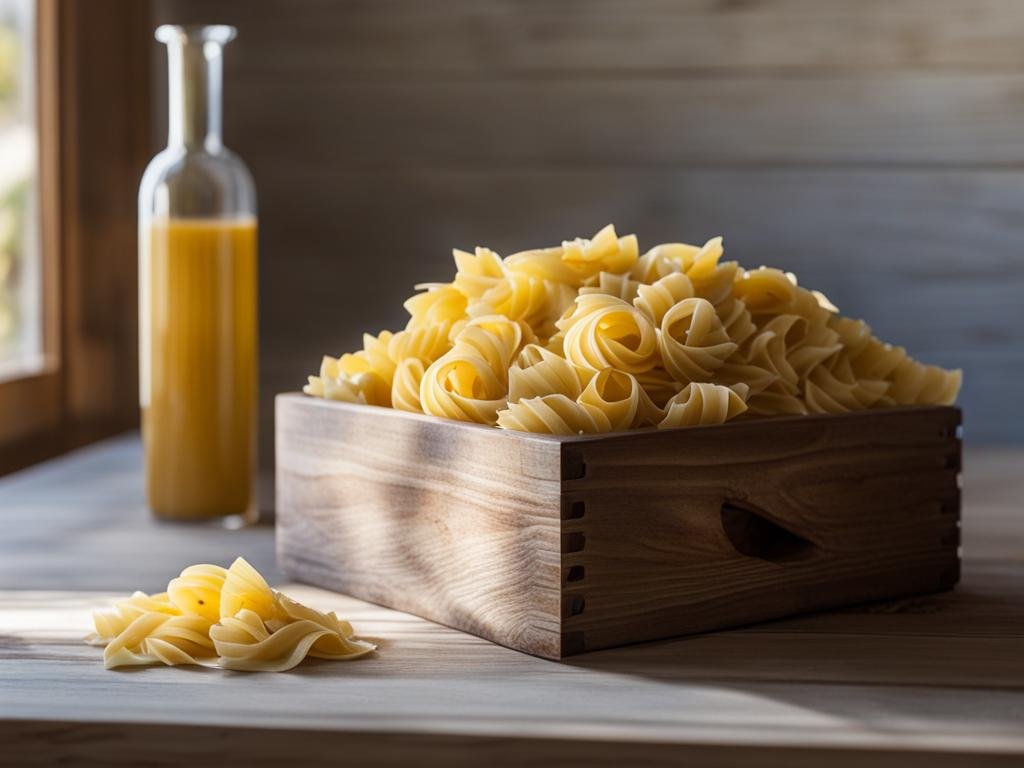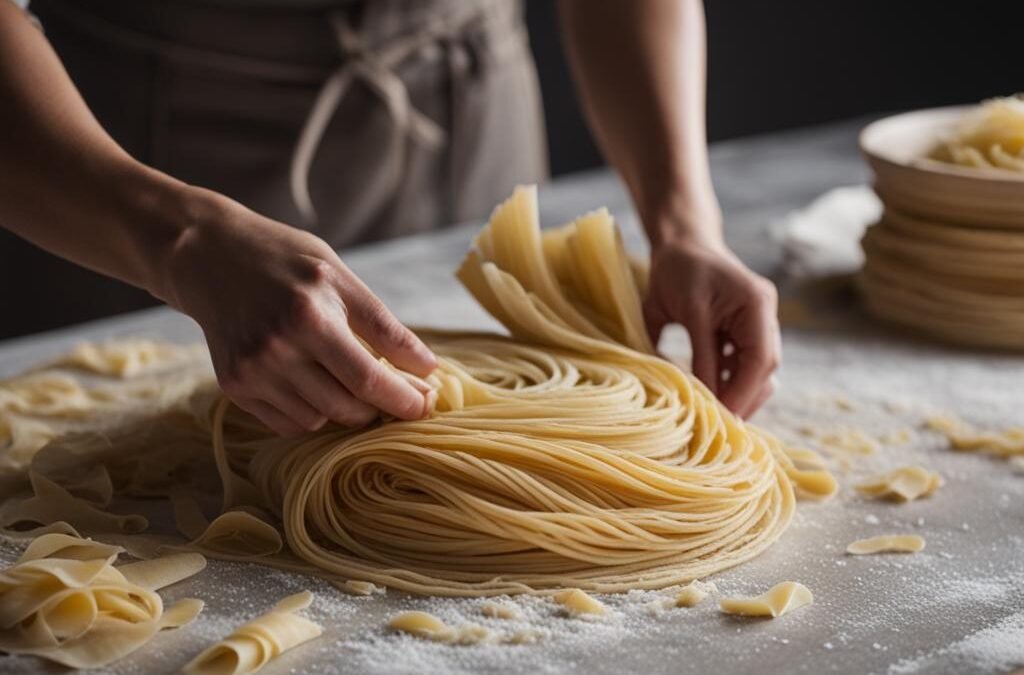Making homemade pasta without a pasta machine or electricity is easier than you might think. With just a few simple ingredients and techniques, you can create delicious pasta right in your own kitchen. Whether you’re looking to satisfy your pasta cravings or seeking a fun culinary project, making homemade pasta without specialized tools is a cost-effective and rewarding option.
Key Takeaways:
- Learning how to make homemade pasta without a pasta machine allows you to enjoy fresh pasta without needing specialized equipment.
- Basic ingredients like flour and eggs are all you need to create the pasta dough.
- Techniques like resting the dough and rolling it out by hand will help you achieve the perfect pasta texture.
- Homemade pasta can be stored at room temperature, refrigerated, or frozen for later use, providing flexibility and convenience.
- By making your own pasta, you have control over the quality of ingredients, allowing you to create healthier and more personalized dishes.
Ingredients for Homemade Pasta Without a Pasta Machine
To make delicious homemade pasta without a pasta machine, you only need a few basic ingredients. The star components of this recipe are flour and eggs, which come together to form the perfect pasta dough. The best part is that you don’t need any specialized equipment or tools to create your own pasta masterpiece.
If you’re wondering what type of flour to use, the choice is yours! You can use ’00’ flour for a delicate texture, semolina flour for a slightly chewier bite, or all-purpose flour for a more versatile option. Experimenting with different flours will allow you to discover your favorite pasta consistency.
Now comes the fun part – mixing the dough. You have two options: you can mix the ingredients together by hand or use a food mixer with a dough hook attachment. Mixing by hand gives you the opportunity to feel the texture of the dough, while a food mixer ensures an evenly combined mixture with ease.
Here’s a basic homemade pasta recipe to get you started:
Ingredients:
- 2 cups of flour (choose your preferred type)
- 3 large eggs
- A pinch of salt
To create your homemade pasta dough, simply follow these steps:
- In a large bowl, combine the flour and salt.
- Create a well in the center of the flour mixture and crack the eggs into it.
- Using a fork, gently beat the eggs, gradually incorporating the flour from the sides of the well as you go along.
- Continue mixing until a shaggy dough forms.
- Transfer the dough to a lightly floured surface and knead for about 5-7 minutes, or until the dough becomes smooth and elastic.
- Wrap the dough in plastic wrap and let it rest at room temperature for 30 minutes.
Now you have your homemade pasta dough ready to be shaped and cooked into your favorite pasta dishes. The possibilities are endless – from classic spaghetti to hearty lasagna or filled ravioli.
Pro tip:
If you’re feeling adventurous, you can experiment with different ratios of flour and eggs to customize the dough according to your taste and desired texture. Just remember to adjust the quantities accordingly and have fun exploring the world of homemade pasta!
Techniques for Homemade Pasta Making Without Equipment
 Making homemade pasta without specialized equipment requires a few techniques to achieve the desired results. Here are some pasta making tips and pasta cooking techniques to help you create delicious homemade pasta without the need for a pasta machine:
Making homemade pasta without specialized equipment requires a few techniques to achieve the desired results. Here are some pasta making tips and pasta cooking techniques to help you create delicious homemade pasta without the need for a pasta machine:
- Rest the dough: After mixing the dough, it’s important to rest it in the fridge for 30 minutes. This allows the gluten to relax, making the dough easier to work with.
- Roll it out: On a lightly floured surface, use a rolling pin to roll out the pasta dough. Roll it as thin as possible to achieve that authentic pasta texture.
- Shape it: Homemade pasta offers endless possibilities when it comes to shapes. You can create lasagna sheets, fettuccine, or even ravioli. Get creative and experiment with different shapes and sizes that suit your preferences.
- Cook it until al dente: Cooking homemade pasta is quick and easy. Simply boil salted water and add the pasta. Cook it until al dente, which means it’s still firm to the bite. This ensures the best texture and flavor.
Tips for Perfect Homemade Pasta
“Making homemade pasta without a pasta machine is a labor of love. It might take a bit more time and effort, but the end result is well worth it. With these techniques and tips, you’ll be able to master the art of homemade pasta without any specialized equipment.” – Chef Marco Rossi
Now that you know the techniques for making homemade pasta without equipment, it’s time to unleash your culinary creativity in the kitchen. Explore different pasta shapes, experiment with flavors, and enjoy the satisfaction of creating your own delicious homemade pasta!
Common Mistakes to Avoid
- Not resting the dough adequately can lead to tough pasta.
- Rolling the pasta too thick can result in a gummy texture.
- Overcooking the pasta can lead to mushy noodles.
- Using too much flour while rolling can make the pasta heavy.
By following these techniques, tips, and avoiding common mistakes, you’ll be well on your way to becoming a pasta-making expert in no time!
Storage Options for Homemade Pasta Without Electricity
 When it comes to homemade pasta without electricity, there are various storage options available to ensure its freshness and longevity. Whether you want to store freshly made pasta at room temperature or extend its shelf life through other methods, there are simple yet effective ways to preserve your delicious creations.
When it comes to homemade pasta without electricity, there are various storage options available to ensure its freshness and longevity. Whether you want to store freshly made pasta at room temperature or extend its shelf life through other methods, there are simple yet effective ways to preserve your delicious creations.
Room Temperature Storage
If you plan to consume your homemade pasta within a few hours, storing it at room temperature can be a convenient option. To do this, distribute the pasta on a floured surface, such as a baking sheet or clean countertop, and leave it uncovered. The airflow will dry out the surface slightly, preventing it from sticking together.
Refrigeration Method
If you need to store pasta for a longer period but don’t have access to electricity, refrigeration is a suitable option. After drying the pasta for a couple of hours, you can cover it loosely with a kitchen towel or plastic wrap and place it in the refrigerator. This method helps maintain the texture and freshness of the pasta for several days.
Drying for Longer Storage
For extended storage without electricity, drying homemade pasta is an effective method. After drying the pasta for a couple of hours, let it dry completely by hanging it or laying it flat on a drying rack. Fully dried pasta can be stored for up to a month in a sealed container, ensuring it retains its quality.
Freezing for Extended Shelf Life
To store homemade pasta even longer, freezing is an excellent option. After drying the pasta for a couple of hours, place it on a surface dusted with semolina flour to prevent sticking. You can freeze the pasta in individual portions or as a whole. When properly stored in an airtight container or freezer bags, frozen homemade pasta can remain good for up to three months.
By utilizing these storage options, you can cherish the taste of your homemade pasta without electricity for an extended period. Whether you prefer room temperature storage, refrigeration, drying, or freezing, each method offers a convenient way to enjoy your pasta whenever the craving strikes.
| Storage Method | Duration |
|---|---|
| Room Temperature | A few hours |
| Refrigeration | Up to several days |
| Drying | Up to a month |
| Freezing | Up to three months |
Experiment with these techniques and find the storage method that best suits your preferences and needs. Whether enjoying your homemade pasta immediately or saving it for later, these storage options allow you to savor the deliciousness of homemade pasta without the need for specialized tools or electricity.
Conclusion
Homemade pasta without a pasta machine or electricity is a versatile and accessible way to enjoy fresh pasta at home. With just a few ingredients and some basic techniques, you can create delicious pasta dishes without the need for specialized tools.
The dough for hand-rolled pasta can be easily made using a rolling pin or even a food mixer. You can experiment with different types of flour to achieve the desired texture, whether it’s delicate fettuccine or sturdy lasagna sheets.
One of the great advantages of making your own pasta is the ability to store and preserve it for later use. You can simply distribute the fresh pasta on a floured surface to dry at room temperature, refrigerate it for short-term storage, or fully dry it for longer storage. Alternatively, freeze the pasta for extended periods, and it will be ready whenever you’re craving a homemade meal.
So why not give it a try? With a hand roll pasta recipe and homemade pasta without specialized tools, you can experience the satisfaction and taste of freshly made pasta right in your own kitchen. Get creative with different shapes and flavors, and enjoy the difference that homemade pasta can make in your meals.
FAQ
How do I make homemade pasta without a pasta machine?
To make homemade pasta without a pasta machine, you can use a rolling pin or a food mixer with a dough hook attachment. Mix flour and eggs together to form the dough, then roll it out thin using a rolling pin on a lightly floured surface.
What ingredients do I need for homemade pasta without a pasta machine?
The main ingredients for homemade pasta without a pasta machine are flour and eggs. You can use different types of flour, such as ’00’ flour, semolina flour, or all-purpose flour, to achieve different textures.
What techniques should I use for homemade pasta making without equipment?
After mixing the dough, let it rest in the fridge for 30 minutes to relax the gluten. Then, roll out the dough using a rolling pin on a lightly floured surface. Roll it as thin as possible and shape it into the desired pasta shapes, like lasagna sheets or fettuccine.
How can I store homemade pasta without electricity?
There are several storage options for homemade pasta without electricity. You can store it at room temperature by leaving it uncovered on a floured surface for a few hours. To refrigerate the pasta for longer storage, cover it after drying for a couple of hours. Another option is to fully dry the pasta and store it in a sealed container for up to a month. Freezing the pasta in portions is also possible by placing it on a floured surface and dusting it with semolina flour.
Why should I make homemade pasta without a pasta machine?
Homemade pasta without a pasta machine is a cost-effective and delicious option for pasta lovers. It allows you to enjoy fresh pasta at home without the need for specialized tools. The dough can be easily stored and preserved, allowing for convenient meal preparation.













